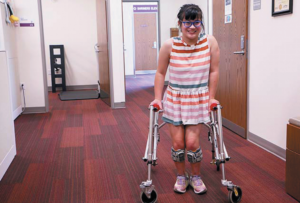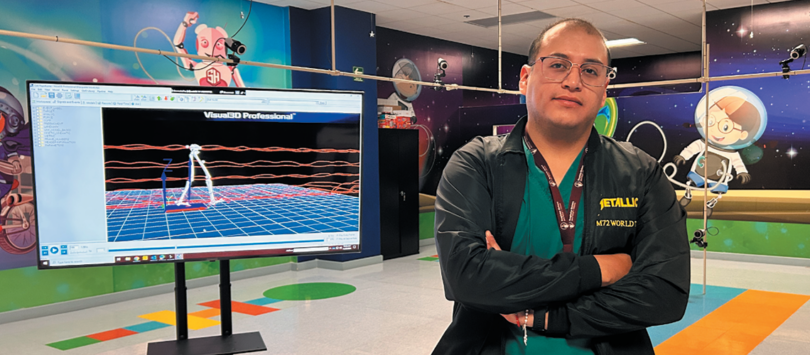
Erica is one of thousands helped by Shriners Children’s motion analysis expertise.
Erica enters the motion analysis center (MAC) at Shriners Children’s Lexington with a smile so wide she can’t help but squint behind her royal blue glasses.
Using a walker, the bubbly 16-year-old with cerebral palsy makes her way into the MAC and readies for a gait analysis. A physical therapist affixes more than a dozen reflective markers on key points of Erica’s hips, legs, knees, ankles and feet.
Cameras situated around the large room pick up these markers and create a digital figure of Erica as she walks. Before surgery, Erica’s feet were turned inward and dragged as she walked, causing trips and falls. The gait analysis will tell her doctors if her surgeries were successful in helping Erica walk without falling.
Setting the standard
Erica is just one of thousands of children who benefit from Shriners Children’s internationally recognized expertise in clinical motion analysis. With the most motion analysis centers of their kind in the world, Shriners Children’s is building something unprecedented: a unified network of 14 innovative labs with the largest team of motion analysis specialists with this level of expertise anywhere. This effort has garnered national recognition and is setting benchmarks for the field of pediatric motion analysis on a global scale.
At the forefront are Shriners Children’s Corporate Director of Motion Analysis Centers Ross Chafetz, Ph.D., PT, DPT, and Corporate Director of Rehabilitation and Therapy Services Kyle Watterson, Ph.D., PT, DPT, who led the charge in making the motion analysis centers’ data more cohesive. “We worked with a skilled team of engineers and physical therapists from across the system who developed and implemented the standardization,” said Dr. Chafetz. With uniform data collection and quality controls, Shriners Children’s can treat 14 biomechanical labs as one giant lab that’s operating in sync.
The benefits are clear. Standardization creates a data translation protocol across different sites, allowing physicians to collaborate and share focused expertise and research. This approach also serves as a best practice for an industry that is growing, with increased use of gait analysis among sports teams and outpatient clinics.
“This approach has the potential to revolutionize patient care, allowing care teams to better understand which surgeries and treatments work best for a patient with similar needs who was treated at another hospital,” said Dr. Chafetz. “Ultimately it’s about providing the best possible care and outcomes for patients.”
For Erica, this data provided critical feedback for her surgeon, Vincent Prusick, M.D. “With surgery, we were able to position her feet in a straight-forward position to decrease the interference her feet were having on each other,” he said. After her surgeries, Erica’s feet don’t drag as much, and she has less risk of falling.
Shaping the future
Shriners Children’s is also pushing the boundaries of the technology. The MACs are testing markerless motion capture systems and wearable sensors that could extend the analysis beyond clinic walls to homes, sporting events and outreach clinics. Shriners Children’s MACs exemplify collaboration, innovation and excellence, setting a new gold standard in motion analysis. As the team continues to build this unparalleled network, it is advancing its own organization and shaping the future of pediatric care worldwide.





